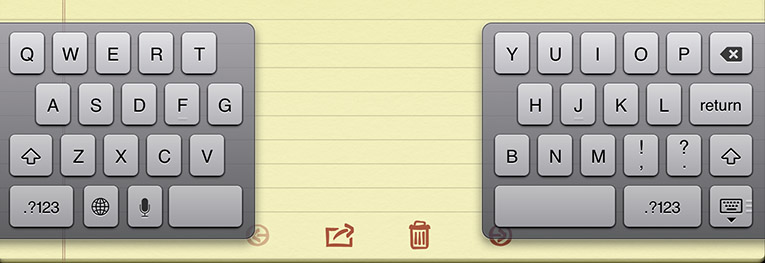iPad Split Keyboard
Backstory
I was working on a secret project in 2008 when it was suddenly and unceremoniously canceled, and I was suddenly looking for a new position at Apple. An opportunity surfaced that seemed to combine my interests in design & technology perfectly: a position on a software prototyping team in the multitouch hardware group.
I had heard of one of the guys on the team through his Magic Ink paper, and needless to say, I was a bit nervous about pitching the concept I had developed for a “design challenge” assignment – a tagging system for Mac OS X that I dubbed Synapse – to someone of Bret Victor’s renown. His insightful demeanour put me at ease, and I managed to land the job.
A few days later, I had the surreal experience of walking into a small room in a secure area of Apple’s hardware labs and seeing a prototype iPad laying on the table. My job for the next couple years was building software prototypes for whatever novel hardware concepts were conjured up.
Thumb Typing on a Tablet
One of the problems that immediately attracted me was how to type quickly on a large multitouch device like the iPad. The plan for text input on iPad seemed highly inefficient, but the idea of a split keyboard had been “laughed out of the room” a few years earlier. Still, I felt it was the best way to type on a tablet form factor device. I imagined doctors holding the iPad in a patient’s room, a wine grower walking through his cellars with the device, or simply needing to type on the iPad while standing up or laying down – the standard keyboard didn’t support these use cases very well.

iPad split keyboard
The challenges of bringing the concept out of the lab an into production were many: aside from the technical hurdles of supporting the 40-odd languages (including Japanese Kana, Emoji, and other layouts that don’t immediately lend themselves to splitting) there were numerous political obstacles to surmount.
The Split Keyboard took almost two and a half years of design, development, cross-functional integration, performance optimization and persistence to get the keyboard integrated into iOS.
Patents

Apple submitted a family of patents for some of the iPad Split Keyboard’s technologies, including the “phantom keys” feature that I invented — the intentionally duplicated keys along the inner edges of the left and right key areas to support the natural crossover that occurs with bi-manual typing.